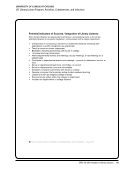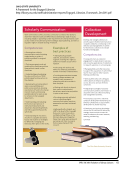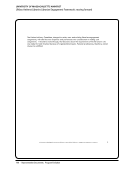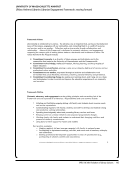74 · Survey Results: Survey Questions and Responses
Librarians new to the department receive a mentor within the department during the first year to assist them in learning
their responsibilities. They meet with various individuals throughout the library to learn the processes they will need to
perform their responsibilities. Meetings with the head of the department are scheduled for the first six months and may
be scheduled on a regular basis or on an informal basis according to the needs of the individual liaison.
Meet with director of public services, director of collection management/scholarly communication meet with functional
specialists (open education resources, GIS, data management)
Mentoring tailored to the discipline and collection development training and public services orientation
Mentoring, etc.
Needs based: training on tools used, mentoring by more senior librarians, show &tell
New liaisons go through a rigorous training program in their department.
Newly hired liaisons meet with domain/functional experts to learn about scholarly communication, open access/agenda
issues, etc.
Not as formal as it used to be, but it happens with new hires.
Not yet, but we will receive training on the IR. We’ve also received some small amount on copyright.
Orientation for new liaisons training on subjects such as, book ordering, creating and maintaining LibGuides, and new
technologies group viewing of webinars and monthly meetings on various topics of need.
Orientations to library organization, introductions to academic departments, training for use of library-specific tools,
e.g., LibAnalytics and LibGuides, and instruction training.
Robust orientation plan includes training in instruction and collection development, work with an assigned mentor (an
experienced liaison librarian), and meetings with departmental colleagues and heads of other library departments.
Senior liaisons provide mentoring. Acquisitions staff provide an orientation. New and old topics related to the liaison
role are presented at twice monthly meetings.
Series of training and orientation sessions within the libraries system
The Engaged Librarian Forum provides professional development &context. The Teaching &Learning department and
other functional specialists provide development opportunities.
The liaison coordinator offers approximately four sessions per year related to new and emerging areas of engagement
(e.g., copyright, open access, research data management, ORCID, grant support). There is a concurrent expectation that
liaisons will also engage in their own self-directed PD through participation in conferences, courses, personal reading
and learning.
There is a liaison training checklist that covers all core job responsibilities, as well as basic library policy and procedures
and university mission.
They are asked to read the papers that our liaisons have published to get an understanding of the program, the activities
we pursue with and for our clients, and how the program has evolved over time. They shadow liaisons, take appropriate
subject-based and other continuing education courses through the Medical Library Association and other venues, and
we discuss at weekly departmental meetings.
This includes both formal and informal meetings with the faculty’s supervisors and colleagues, as well as an ongoing
education through meeting with academic department contacts.
Librarians new to the department receive a mentor within the department during the first year to assist them in learning
their responsibilities. They meet with various individuals throughout the library to learn the processes they will need to
perform their responsibilities. Meetings with the head of the department are scheduled for the first six months and may
be scheduled on a regular basis or on an informal basis according to the needs of the individual liaison.
Meet with director of public services, director of collection management/scholarly communication meet with functional
specialists (open education resources, GIS, data management)
Mentoring tailored to the discipline and collection development training and public services orientation
Mentoring, etc.
Needs based: training on tools used, mentoring by more senior librarians, show &tell
New liaisons go through a rigorous training program in their department.
Newly hired liaisons meet with domain/functional experts to learn about scholarly communication, open access/agenda
issues, etc.
Not as formal as it used to be, but it happens with new hires.
Not yet, but we will receive training on the IR. We’ve also received some small amount on copyright.
Orientation for new liaisons training on subjects such as, book ordering, creating and maintaining LibGuides, and new
technologies group viewing of webinars and monthly meetings on various topics of need.
Orientations to library organization, introductions to academic departments, training for use of library-specific tools,
e.g., LibAnalytics and LibGuides, and instruction training.
Robust orientation plan includes training in instruction and collection development, work with an assigned mentor (an
experienced liaison librarian), and meetings with departmental colleagues and heads of other library departments.
Senior liaisons provide mentoring. Acquisitions staff provide an orientation. New and old topics related to the liaison
role are presented at twice monthly meetings.
Series of training and orientation sessions within the libraries system
The Engaged Librarian Forum provides professional development &context. The Teaching &Learning department and
other functional specialists provide development opportunities.
The liaison coordinator offers approximately four sessions per year related to new and emerging areas of engagement
(e.g., copyright, open access, research data management, ORCID, grant support). There is a concurrent expectation that
liaisons will also engage in their own self-directed PD through participation in conferences, courses, personal reading
and learning.
There is a liaison training checklist that covers all core job responsibilities, as well as basic library policy and procedures
and university mission.
They are asked to read the papers that our liaisons have published to get an understanding of the program, the activities
we pursue with and for our clients, and how the program has evolved over time. They shadow liaisons, take appropriate
subject-based and other continuing education courses through the Medical Library Association and other venues, and
we discuss at weekly departmental meetings.
This includes both formal and informal meetings with the faculty’s supervisors and colleagues, as well as an ongoing
education through meeting with academic department contacts.












































































































































































































